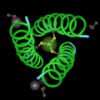 Although, I didn't believe it when I first saw it. With all the years that I've heard (or taught) that all DNA is antiparallel, it was hard to believe my eyes.
Although, I didn't believe it when I first saw it. With all the years that I've heard (or taught) that all DNA is antiparallel, it was hard to believe my eyes.
Yet here is parallel DNA, with both strands oriented in the same direction, right here on your monitor. And the commenters were correct.
tags: DNA structure, DNA , molecular structure, biochemistry
The image that I posted a couple of days ago was made from part of this same structure. In that image, I hid the rest of the bases to make it easier to see why this structure is so strange.
Here are two images that show the landmarks a bit better. I hid the hydrogens and used different rendering styles to emphasize key features in the sugar phosphate backbone.

 Part of the mystery is what the people who deposited this structure were trying to do in the first place and why they synthesized this molecule. Unfortunately, the article that's referenced in the database is in a journal that's not indexed by PubMed or Google and there isn't a PubMed Central reference.
Part of the mystery is what the people who deposited this structure were trying to do in the first place and why they synthesized this molecule. Unfortunately, the article that's referenced in the database is in a journal that's not indexed by PubMed or Google and there isn't a PubMed Central reference.
We're left to wonder.
But if you want to find out, and you have access to a good library, the reference is below.
Reference
Venkitakrishnan,R.P. et. al. 2004. A Parallel Stranded Dna Duplex With An A-G Mismatch Base-Pair:
(Ccataatttacc:cctatgaaatcc). Recent Trends In Biophys.Res., 1

While you're on the subject of weird DNA structures, don't forget 3- and 4-stranded DNA.
I HAVE BEEN TOLD THAT I HAVE PARALLEL DNA. WHERE CAN I FIND MORE ABOUT THIS TYPE AND WHAT DOES IT MEAN. I COME FROM EASTERN EUROPE. JERRY
Hi Jerry,
Rest assured you do NOT have parallel DNA. Your DNA is anti-parallel, which means that the two strands are oriented in opposite directions.
This DNA in the picture was made in the laboratory, not in a biological system.
The "parallelness" of nucleic acids is not new at all and dates way back to Rich, Davies, Watson & Crick. (low pH structure of poly A). In the late 80's and early 90's there were a spate of papers describing parallel stranded unmodified DNA and normal solution conditions. (see also the 1988 Science paper).
...... and of course anytime you have 3 or more strands 2 of them will be parallel.